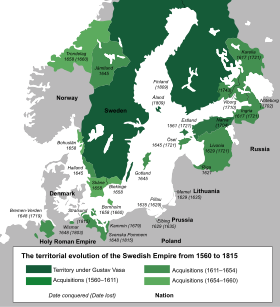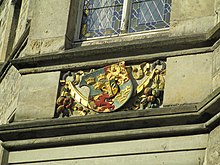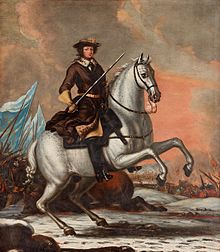Swedish Empire


| History of Sweden |
|---|
 |
| Timeline |
|
|
The Swedish Empire (Swedish: stormaktstiden, "the Era of Great Power")[1] was the period in Swedish history spanning much of the 17th and early 18th centuries during which Sweden became a European great power that exercised territorial control over much of the Baltic region. The beginning of the period is usually taken as the reign of Gustavus Adolphus, who ascended the throne in 1611, and its end as the loss of territories in 1721 following the Great Northern War.[1]
After the death of Gustavus Adolphus in 1632, the empire was controlled for lengthy periods by part of the high
After its victories in the Thirty Years' War and the subsequent Peace of Westphalia Sweden was granted territories in northern Germany. Sweden reached the height of its power during the Second Northern War, when its primary adversary, Denmark–Norway, was neutralized by the Treaty of Roskilde in 1658. Denmark–Norway was forced to give up a third of its territory to save the rest.[2] Although the reign of Charles XII would see initial Swedish victories in the Peace of Travendal (1700) and the Treaty of Altranstädt (1706), he would go on to lead a campaign in Russia that would end in a staggering defeat for the Swedes. The Russian victory at the Battle of Poltava put an end to Sweden's eastbound expansion, and by the time of Charles XII's death in 1718 the Empire had been severely diminished both territorially and militarily. The last traces of occupied continental territory vanished during the Napoleonic Wars, and Finland went to Russia in 1809, marking the end of Sweden’s period as a great power.
History
Emergence as a great power
Sweden emerged as a great European
During the Thirty Years' War, Sweden managed to conquer approximately half of the member states of the Holy Roman Empire. The fortunes of war would shift back and forth several times. After its defeat in the Battle of Nördlingen (1634), confidence in Sweden among the Swedish-controlled German states was damaged, and several of the provinces refused further Swedish military support, leaving Sweden with only a couple of northern German provinces. After France intervened on the same side as Sweden, fortunes shifted again. As the war continued, the civilian and military death toll grew, and when it was over, it had led to severe depopulation in the German states. Although exact population estimates do not exist, historians estimate that the population of the Holy Roman Empire fell by one-third as a result of the war.[3]
Sweden founded overseas colonies, principally in the New World. New Sweden was founded in the valley of the Delaware River in 1638, and Sweden later laid claim to a number of Caribbean islands. A string of Swedish forts and trading posts was constructed along the coast of West Africa as well, but these were not designed for Swedish settlers.
Peace of Westphalia
At the conclusion of the Thirty Years' War, the
Through the efforts of Johan Oxenstierna and Johan Adler Salvius it obtained:
- Swedish Pomerania, the Swedish share of the former Duchy of Pomerania since the Treaty of Stettin (1653), consisting of
- Stettin, Greifswald, and Stralsund;
- a strip of Hohenzollerns;
- the town of Wismar, with the districts of Pod and Neukloster;
- the secularized bishoprics of Bremen-Verden, with the town of Wildeshausen; and
- 5,000,000 Riksdaler.[4]
These German possessions were to be held as fiefs of the Holy Roman Empire. This allowed Sweden a vote in the Imperial Diet and enabled it to "direct" the Lower Saxon Circle alternately with Brandenburg. France and Sweden, moreover, became joint guarantors of the treaty with the Holy Roman Emperor and were entrusted with carrying out its provisions, as enacted by the executive congress of Nuremberg in 1650.[4]
After the peaces of
Domestic consolidation
For the moment,
Charles X Gustav was a strong arbiter between the people and the nobility. Primarily a soldier, he directed his ambition towards military glory; but he was also an unusually sharp-sighted politician. While placing great emphasis on military strength, he also understood that domestic unity was necessary for a powerful foreign policy.[4]
The most pressing domestic question was the
Charles X Gustav had done his best to recover from the financial extravagance of Christina. However, his own desire for military glory may have caused problems for his country. In three days, he persuaded the Swedish estates of the potential of his attack on the
Peace of Oliva
The
Thus, Sweden emerged from the war not only a military power, but also one of the largest states of Europe, possessing more than twice as much territory as modern Sweden. The land area of Sweden was 1,100,000 km2. While modern Sweden is bounded by the Baltic, during the 17th century the Baltic formed a bond between various widely dispersed
Danish defeat
Sweden had now won considerable political influence, which was lessened by the loss of moral prestige. On
In 1660, after five years of warfare, Sweden had obtained peace and the opportunity to organize and develop the new vast realm. The fifteen-year regency that followed Charles X Gustav was unable to manoeuvre through the situation it faced. The administration was internally divided and hindered by the lack of unity and talent among its statesmen. The two major rivals were the military-aristocratic party headed by
Scanian War
In 1674, Louis XIV called upon Sweden to invade the
At this point, the empire began to crumble. In 1675,
Through homeland military successes of the young Swedish king and the diplomatic activity of Louis XIV, a peace congress began sessions at Nijmegen in March 1677. In the beginning of April 1678, the French king dictated the terms of a peace. One of his chief conditions was the complete restitution of Sweden, as he needed a strong Swedish ally. However, Charles XI refused to go along with ceding territories to its enemies, which led the French king to negotiate on behalf of Sweden without its consent. By the Treaties of Nijmegen on 7 February and of St. Germain on 29 June 1679, Sweden received almost full restitution of its German territory. By the Treaty of Fontainebleau confirmed by the subsequent Peace of Lund on 2 September, Denmark–Norway was to return all the land it had captured to Sweden on 4 October 1679. While Sweden could never have gained these concessions alone, Charles XI formed a personal dislike of the French king and developed a strong anti-French bias.[8]
Charles XI
The remainder of the reign of Charles XI is remarkable for a revolution, in which the government of Sweden was transformed to a semi-absolute monarchy. The king emerged from the war convinced that if Sweden were to retain its position as a great power, it needed to reform its whole economic system radically and circumscribe the power of the aristocracy. Charles XI felt that he could do it now that he had allies in the lower orders to support him.[9]
The

Thus, Sweden had become an absolute monarchy but enacted the right of the Swedish people, in parliament, to be consulted on all important matters. The Riksdag, completely overshadowed by the Crown, did little more than register the royal decrees during the reign of Charles XI of Sweden; but it continued to exist as an essential part of the government. Moreover, this transfer of authority was a voluntary act. The people, knowing the king to be their ally, trusted and cooperated with him.[citation needed] The Riksdag of 1682 declared that the king was empowered to bestow fiefs and take them back again, making the king the disposer of his subjects' temporal property. Presently, this new principle of autocracy was extended to the king's legislative authority, when on 9 December 1682, all four estates not only confirmed that the king held the legislative powers enjoyed by his predecessors, but even gave him the right of interpreting and amending the common law.[9]
The recovery of the alienated crown lands occupied Charles XI for the rest of his life. He created a commission, which was ultimately converted into a permanent department of state. It acted on the principle that the titles of all private landed estates might be called in question, because at some time or other they must have belonged to the Crown, and the burden of proof of ownership lay with the actual owner of the property, not the Crown. The amount of revenue accruing to the Crown from the whole "Reduktion" is impossible to estimate; but by these means, combined with careful management and rigid economy, Charles XI reduced the national debt by three quarters.[9]
Charles XI re-established on a broader basis the reorganization of the "indelningsverk" — a system of military tenure in which national forces were bound to the soil. This tied to the "rust hail tenure", under which the tenants, instead of paying rent, were obliged to equip and maintain a cavalry soldier and horse; while the knekthållare supplied duly equipped foot soldiers. Soldiers were provided with holdings on which they lived in times of peace. Formerly, ordinary conscription had existed alongside this indelning, or distribution system, but it had proved inadequate as well as highly unpopular, and in 1682, Charles XI ended it in favor of an extended distribution system. The
Charles XII and the Great Northern War

After Charles XI's death, the throne was inherited by his underage son,
In the meantime, Russia had managed to take possession of several towns by the Baltic Sea. Instead of trying to retake these, Charles chose to march directly on Moscow, but due to extreme weather, difficulties with his
Despite these setbacks, Charles XII twice tried to invade Norway to force Denmark-Norway out of the war again. On 30 November 1718, King Charles XII was mortally wounded during the siege of Fredriksten Fortress in Fredrikshald, today's Halden. With his death, Swedish war efforts mostly came to a halt, although Russia continued to harass the civilian population of the Swedish coastal areas until the concluding Treaty of Nystad was finally signed in 1721. Sweden would remain a regional power of varying success until the 19th century, but the Great Northern War put an end to Sweden's time as a great power.
Dominions

As a result of eighteen years of war, Sweden gained small and scattered possessions, but had secured control of three principal rivers in northern Germany—the
Military history
A major reason why Sweden could be so successful in wars with such a scarce number of soldiers was its advanced military tactics. Sweden was able to reform its military tactics continuously throughout the period. Prior to Gustavus Adolphus's reforms, both his father, Charles IX, and his uncle
Gustav II Adolph inherited the Polish war together with the
By the time of the
At the time Finns were an essential part of the Swedish military. Roughly 2/5 of the infantry and 3/7 of the cavalry in the army were from Finland.[when?][11] They served in their own units which used Finnish as their main language. Also commands were given in Finnish.[12] The Finnish cavalry in the Swedish army was called Hakkapeliitat after their battle cry "Hakkaa päälle!". Approximately 110,000 soldiers from Finland died serving the Swedish Empire between 1617 and 1721. Relative to the contemporary population of Finland, this was equivalent to over a million of them dying in 20th-century Finland.[13]
Throughout the Thirty Years' War, the infantry's shock ability was continuously improved. The static nature of the infantry that served well against the cavalry-dominated Polish-Lithuanian army was enhanced during the war to produce infantry capable of both providing devastating firepower and executing offensive maneuvers. Initially, at the Battle of Breitenfeld (1631), the infantry was almost entirely reliant on their firepower and saw very limited offensive use; but under the leadership of Johan Banér, who took command after the defeat at Nördlingen, the Gustavian brigade system was finally changed into the battalion system recognisable from the War of the Spanish Succession and the Great Northern War (the depth was lowered from six ranks to three or four when the bayonet was introduced at the end of the 17th century).[citation needed]
Swedish tactics once again greatly diverged from the continental tactics during the second half of the 17th century. The continental tactics increasingly emphasized the firepower of the battalion, while the Swedish (Carolean) tactics almost exclusively relied on the shock factor as the infantry and cavalry charged the enemy. As the bayonet was introduced, the pike was discarded in all armies except the Swedish and Russian by 1700.[citation needed]
In the Swedish army tactics of that time, retreat was never covered, and they were obliged to attack or fight where they stood. This was a military doctrine that (with the advantage of hindsight) might have proven a bit rash.[citation needed]
The infantry shock attack operated as follows. The two rear ranks of musketeers were ordered to shoot when "you could not miss," a range of roughly 50 meters, and then to draw their swords before the battalion resumed their attack. The two foremost ranks then discharged at a range of roughly 20 meters before drawing their swords, and the charge began. At this range, the powerful muskets usually felled many enemy troops and was demoralising to them. Directly after the volley, the Swedes charged the enemy ranks with pikes, bayonets and sabres. Note that the pikes were used as an offensive weapon: in close combat, they had the advantage over their foes' weapons thanks to their range. After the bayonet was introduced in the Carolean army (1700–1706), the final volley was delayed until the soldiers were inside bayonet range.
Every infantry battalion had grenadiers attached. They supported the infantry attack by lobbing grenades from the flanks. They also formed units of their own. They were otherwise equipped like infantry.
Thus, in the latter half of the 17th century, the major difference between the Swedish army and those common on the continent was the relative lack of firepower and the use of pikes and sabres. Sweden and Russia were the only countries at the time using pikes. In contemporary Europe, infantry were equipped with a musket, while in the Swedish army, every third man had a pike. The pikemen were normally deployed four men deep with musketeers of equal depth on the sides. The pike was used to repulse cavalry and to break the enemy lines as they charged.
Gallery of the Swedish monarchs during the imperial era
-
King Gustav II Adolph "Gustavus Adolphus"
-
Queen Christina
-
King Carl X Gustav
-
King Carl XI
-
King Carl XII
-
Queen Ulrica Eleanor
-
King Frederick
See also
References
- ^ ISBN 978-0-582-06429-4.
- ^ Nicklas, Thomas (2002). Macht oder Recht. Frühneuzeitliche Politik im obersächsischen Reichskreis [Power or Right: Early modern politics in the Upper Saxon Circle] (in German). Stuttgart. p. 282.
Finanziell völlig von französischen Subsidien abhängig, wollte sich die Großmacht auf tönernen Füßen [...]
{{cite book}}: CS1 maint: location missing publisher (link) - ^ De Vries, Jan (2009). "The economic crisis of the seventeenth century after fifty years". The Journal of Interdisciplinary History. 40 (2): 160.
- ^ a b c d e f g Dumrath 1911, p. 203.
- ^ Hayes, Carlton J. H. (1916). A Political and Social History of Modern Europe. Archived from the original on 17 November 2007.
- ^ Dumrath 1911, pp. 203–204.
- ^ a b c d e f Dumrath 1911, p. 204.
- ^ Dumrath 1911, pp. 204–205.
- ^ a b c d e Dumrath 1911, p. 205.
- OCLC 70554282.
- ISBN 978-952-222-606-8.
- ISBN 9780880292603.
- ISBN 9789522346384.
- This article incorporates text from a publication now in the public domain: Dumrath, Oskar Henrik (1911). "Sweden". In Chisholm, Hugh (ed.). Encyclopædia Britannica. Vol. 26 (11th ed.). Cambridge University Press. pp. 188–221.
Further reading
- Andersson, Ingvar (1956). A History of Sweden. New York: Praeger. free to borrow for two weeks pp 153–237
- Bain, R. Nisbet. Charles XII and the Collapse of the Swedish Empire, 1682–1719 (1899) online
- Brems, Hans. "Sweden: From Great Power to Welfare State" Journal of Economic Issues 4#2 (1970) pp. 1–16 online
- Evans, Malcolm (1997). Religious Liberty and International Law in Europe. Cambridge University Press. ISBN 0-521-55021-1.
- Kirby, David. Northern Europe in the Early Modern Period: The Baltic World 1492 - 1772 (1990).
- Lisk, Jill. The Struggle for Supremacy in the Baltic 1600 - 1725 (1967).
- Lockhart, Paul Douglas. Sweden in the Seventeenth Century (2004).
- Magnusson, Lars (2000). An Economic History of Sweden. London: Routledge. ISBN 0-415-18167-4.
- Moberg, Vilhelm; Austin, Paul Britten (2005). A History of the Swedish People: Volume II: From Renaissance to Revolution.
- Oakley, Stewart. Scandinavian History 1520 - 1970 (1984).
- Roberts, Michael. Sweden as a Great Power 1611 - 1697 (1968).
- Roberts, Michael. Sweden's Age of Greatness 1632 - 1718 (1973).
- Roberts, Michael. The Swedish imperial experience 1560–1718 (Cambridge UP, 1984).
- Roberts, Michael. From Oxenstierna to Charles XII: Four Studies (Cambridge UP, 1991).
- Upton, A. Charles XI and Swedish Absolutism (Cambridge University Press, 1998).
- Warme, Lars G. (1995). A History of Swedish Literature.
Historiography and memory
- Kirby, David. "Imperial Sweden – Image and Self-Image" History Today 40:11 (1990): 34–39.
- Stadin, Kekke. "The masculine image of a great power: Representations of Swedish imperial power c. 1630–1690." Scandinavian journal of history 30.1 (2005): 61–82.
- Thomson, Erik. "Beyond the Military State: Sweden’s Great Power Period in Recent Historiography." History Compass 9.4 (2011): 269–283 online[dead link].







